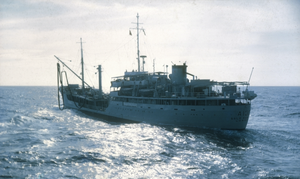RFA Gold Ranger

| |
| History | |
|---|---|
| Name | Gold Ranger |
| Ordered | 28 August 1939 |
| Builder | Caledon Shipbuilding Co Ltd |
| Yard number | 389 |
| Laid down | 14 May 1940 |
| Launched | 12 March 1941 |
| Decommissioned |
|
| In service | 4 July 1941 |
| Out of service | July 1973 |
| Identification |
|
| Fate |
|
| General characteristics | |
| Class and type | Ranger-class fleet support tanker |
| Tonnage | |
| Displacement | 6,700 long tons (6,808 t) full load |
| Length | 365 ft 4 in (111.35 m) |
| Beam | 47 ft (14 m) |
| Draught | 22 ft 2 in (6.76 m) |
| Propulsion |
|
| Speed | 13 knots (15 mph; 24 km/h) |
| Range | 6,000 nmi (11,000 km) at 14.5 kn (16.7 mph; 26.9 km/h) |
| Complement | 40 |
RFA Gold Ranger (A130) was a Ranger-class fleet support tanker of the Royal Fleet Auxiliary which first served in World War II.
In December, 1949, she supported Operation Corkscrew by providing aviation fuel at Deception Island for aircraft which helped relieve men of the Falkland Islands Dependencies Survey at Base E on Stonington Island. She later served in the Korean War, and in support of the atomic tests at Mauro Atoll. She was later employed as a support ship for minesweepers during the Indonesian Confrontation.
In 1972 she brought the expedition members of the Joint Services Egmont Islands Expedition (JSEI) from Gan, Addu Atoll to the Egmont Atoll. Led by Sqn Leader "Dickie" Bird RAF, it was the first scuba diving expedition in the Chagos Archipelago.[1] Following its success, a second expedition was undertaken to Danger Island the following year.[2]
References
- ^ The History of Army Recreational Diving and the Army Sub-Aqua Diving Association (ASADA)
- ^ Baldwin, EA (ed.), A report on the Joint Services Expedition to Danger Island in the central Indian Ocean, December 1974 to April 1975, Ministry of Defence Publication, London 1975
